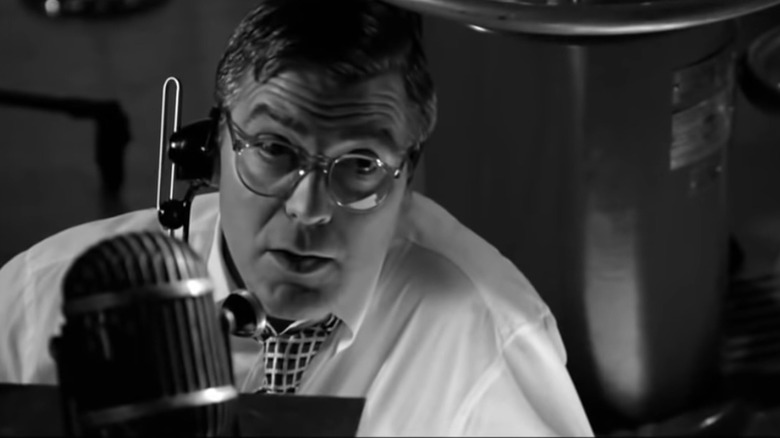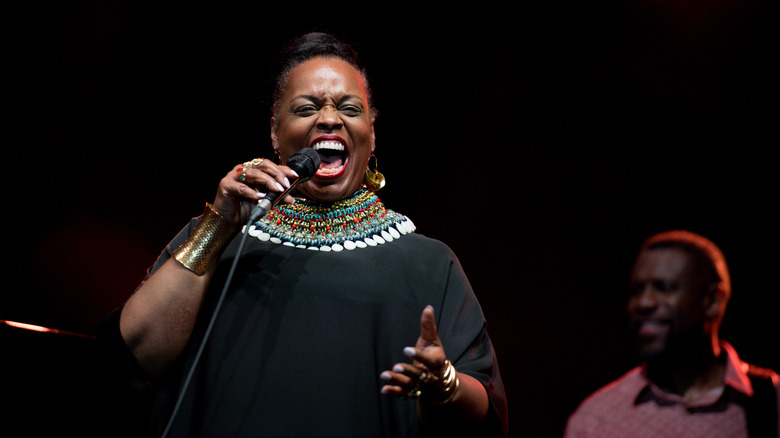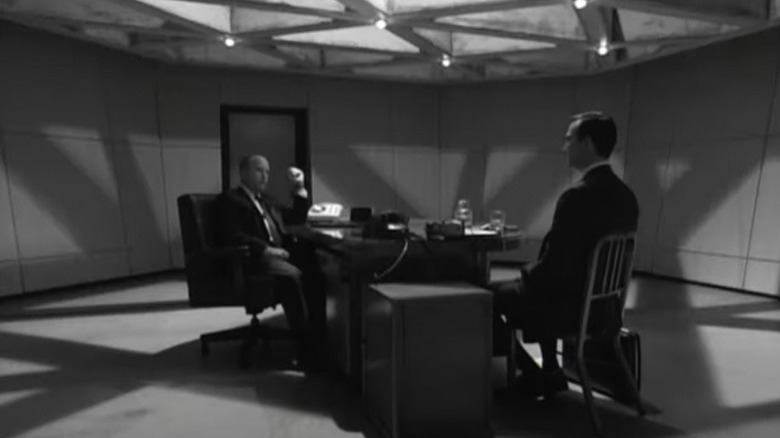Good Night, And Good Luck Took A Cue From One Of George Clooney's Favorite Films
Television isn't a medium known for quiet and austerity. But when George Clooney directed his 2005 feature film, "Good Night, and Good Luck," a Cold War thriller set in the CBS newsroom, he preferred dead air for much of his score.
That film pitted revered CBS journalist Edward R. Murrow against the leader of the Communist witch-hunt, Senator Joseph McCarthy. Much of the action takes place behind Murrow's desk, and Clooney ratchets up the tension by choosing to fill the space between dialogue with silence and stressed puffs of cigarette smoke.
Clooney's deliberate choice of stillness harkens back to one of his favorite Cold War movies, Sidney Lumet's "Fail Safe." The 1964 film follows the American president as he scrambles to recall nuclear bombers heading toward Moscow following a defense system malfunction.
In an interview with Hollywood.com, Clooney talked about how "Fail Safe" informed his approach to building suspense in "Good Night and Good Luck."
"I always found that we're at a time right now where everyone is afraid that you're not going to be able to hold people's attention unless you have bells and things going off all of the time. And if you watch 'Fail Safe' there is this stunning silence. And silence is really important. And I found that the tension in the film — I think of it as an action film — but the tension in the film is all in the silence of it, and what is said in the moments when you are counting down and waiting and watching. I mean, I love it."
A moral point of view
The only music in "Good Night and Good Luck" comes from the cool, mellifluous tones of contemporary jazz singer Dianne Reeves. Clooney himself tapped Reeves for the part because she was a favorite of his famous aunt, Rosemary Clooney. The director not only wanted her on the soundtrack, but actually on film singing in CBS Studio 58. The decision proved effective: The soundtrack earned Reeves her fourth Grammy for best jazz vocal. But as Clooney explained to Hollywood.com, he chose to include only three songs, using Reeves as a narrator to highlight dramatic points in the film.
"I knew that I was going to frame Don Hollenbeck's suicide around the song 'How High the Moon' from the very beginning. So Dianne Reeves actually sent me a tape singing 'How High The Moon' and it was great ... I like that era of music, and I wanted her to be sort of the Joel Grey in 'Cabaret.' I wanted her to be this sort of moral point of view that you could constantly go back to."
'It looks like a porno film without the sex'
"Good Night, and Good Luck" did not mark the first time that Clooney returned to the sober aesthetic of "Fail Safe." In 2000, CBS staged a live remake of the film starring Richard Dreyfuss and Noah Wyle. Clooney executive produced the remake and lent his star power in front of the camera playing a minor role as U.S. Air Force pilot Col. Jack Grady, while veteran CBS journalist Walter Cronkite added gravitas as host of the teleplay. Like "Good Night, and Good Luck," the CBS production of "Fail Safe" opted for an unsettling silence that provided a stark contrast to the flashy HBO dramas and boisterous game shows that jockeyed for viewers' attention in the same time slot. The production also sought to ground "Fail Safe" in its Cold War setting by shooting the live play in black-and-white.
"We learned, first of all, that you have to film it in black-and-white and not in color, because the look in color doesn't look right," Clooney said in an interview ahead of the televised production. "It looks like a porno film without the sex."
While "Good Night, and Good Luck" was obviously not a live production, it's clear Clooney leaned on his experiences with "Fail Safe" — both as a fan and as a participant — to inform his own black-and-white period piece a few years later.


